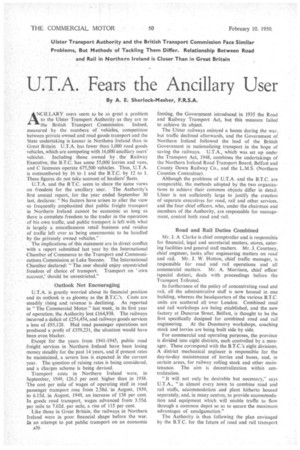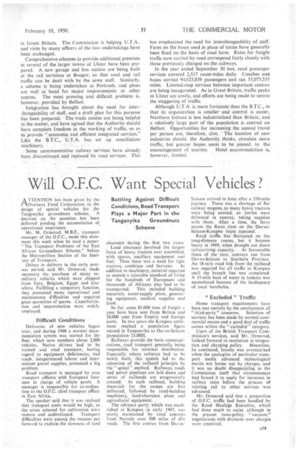U.T.A. Fears the Ancillary User
Page 54

Page 57

If you've noticed an error in this article please click here to report it so we can fix it.
By A. E. Sherlock-Mesher, F.R.S.A. Ulster Transport Authority and the British Transport Commission Face Similar Problems, But Methods of Tackling Them Differ. Relationship Between Road and Rail in Northern Ireland is Closer Than in Great Britain
ANCILLARY users seern to be as great a problem to the Ulster Transport Authority as they are to the British Transport Commission. Indeed, measured by the numbers of vehicles, competition between private owned and road goods transport and the State undertaking is keener in Northern Ireland than in Great Britain U.T.A. has fewer than 1,000 road goods vehicles, which are competing with 16,000 ancillary users' vehicles. Including those owned by the Railway Executive, the B.T.C. has some 55,000 lorries and vans, and C licensees operate 675,500 vehicles. Thus, U.T.A. is outnumbered by 16 to 1 and the B.T.C. by 12 to 1. These figures do not take account of hauliers' fleets.
U.T.A. and the B T.C. seem to share the same views on freedom for the ancillary user. The Authority's first annual report, for the year ended September 30 last, declares: "No. factors have arisen to alter the view so frequently emphasized that public freight transport in Northern Ireland cannot be economic so long as there is complete freedom to the trader in the operation of his own traffic, and public transport is left with what is largely a miscellaneous retail business and residue of traffic left over as being uneconomic to be handled by the privately owned vehicles."
. The implications of this statement are in direct conflict with a report submitted last year by the International Chamber of Commerce to.the Transport and Communications Commission at Lake Success. The International Chamber declared: "The. user should enjoy unrestricted , freedom of choice of transport. Transport on 'own account,' should be unrestricted."
" . Outlook Not Encouraging . .
U.T.A. is greatly worried about its financial position and its outlook is as gloomy as the 13.T.C.'s. Costs are steadily rising and: revenue is declining. As reported in "The Commercial. Motor " last week, in its first year of operation, the Authority lost £164,938. The railways incurred a deficit of £254,454, and railways goods services a loss of £93,128. Had road passenger operations not produced a profit of £359,231, the situation would have been even blacker.
Except for the years from 1941-1945, public road freight services in Northern Ireland have. been losing money steadily for the past 14 years, and if present rates be maintained, a .Severe loss is expected in the current year. The question of raising rates is being considered, and a dharges scheme is beingdevised.
Transport costs in Northern Ireland were, in September, 1949, 126.5 per cent higher than in 1938. The cost per mile of wages of operating staff in road passenger transport rose from 2.58d.' in August, 1939; to 6.15d. in August, 1949, an increase of 138 per cent. In goods road transport, wages advanced from 3.55d. per mile to 7.62d. per mile, a rise of 115 per cent..
Like those in Great Britain, the railways in Northern Ireland were in poor financial shape before the war. In an attempt to put public transport on an economic 306
footing, the Government introduced in 1935 the Road and 'Railway Transport Act, but this measure failed to achieve its object.
The Ulster railways enjoyed a boom during the war, but traffic declined -afterwards, and the Government of Northern Ireland followed the lead of the British Government in nationalizing transport in the hope of saving the railways. U.T.A., which was set up under the Transport Act, 1948, combines the undertakings of the Northern Ireland Road Transport Board, Belfast and County Down Railway Co., and the L.M.S. (Northern Counties Committee).
Although the problems of U.T.A. and the B.T.C. are comparable, the methods adopted by the two organizations to achieve their common objects differ in detail. Ulster is not sufficiently large to justify the creation of separate executives for road, rail and other services, and the four chief officers, who, under the chairman and members of the Authority, are responsible for management, control both road and rail.
Road and Rail Duties Combined
Mr. J. A Clarke is chief comptroller and is responsible for financial, legal and secretarial matters, stores, catering facilities and general staff matters. Mr. J. Courtney, chief engineer, looks after engineering matters on road and rail. Mr. J. W. Hutton, chief. traffic manager, is responsible for road and rail operations and all commercial matters. Mr. A. Morrison, chief officer (special duties), deals with proceedings before the Transport Tribunal.
In furtherance of the policy of concentrating road and rail, all the administrative staff is now housed in one building, whereas the headquarters of the various B.T.C. units are scattered all over London. Combined road and rail workshops are being established, and the new factory at Duncrue Street, Belfast, is thought to be the first specifically designed for combined road and rail engineering. • At the Dunmurry workshops, coaching stock and lorries are being built side by side.
For commercial and operating purposes, the province is divided into eight districts, each controlled by a manager. These correspond with the B.T.C.'s eight divisions. A district mechanical engineer is responsible for the day-to-day maintenance of lorries and buses, and, in certain areas, for railway rolling stock and other maintenance. The aim is decentralization within centralization.
"It will not only be desirable but necessary," says U.T.A., "in almost every town to combine road and rail staffs, accommodation and plant hitherto housed separately, and, in many centres, to provide accommodation and equipment which will enable traffic to flow through a common depot so as to secure the maximum advantages of amalgamation."
The Authority is thus following the plan envisaged by the B.T.C. for the future of toad and rail transport
to Great Britain. The Commission is helping U.TA., and visits by many officers of the two undertakings have been exchanged.
Comprehensive schemes to provide additional premises in several of the larger towns of Ulster have been prepared. A new garage and bus station are being built at the rail terminus at Bangor, so that road and rail traffic can be dealt with by the same staff. Similarly, a scheme is being undertaken at Portrush, and plans are well in hand for major improvements at other centres. The most pressing and difficult problem is, however, provided by Belfast.
Integration has brought about the need for interLthangeability of staff, and a draft plan for this purpose has been prepared. The trade unions are being helpful in the matter, and have agreed that the Authority should have complete freedom in the working of traffic, so as to provide " economic and efficient integrated services.Like the B.T.C., U.T.A. has set up conciliation machinery.
Some unremunerative railway services, have already been discontinued and replaced by road services. This
has emphasized the need for interchangeability of staff. Fares on the buses used in place of trains have generally been fixed on the basis of road fares. Rates for freight traffic now carried by road correspond fairly closely with those previously charged on the railways.
In the year ended September 30 last, road passenger services covered 2,517 route-miles daily. Coaches and buses carried 94,623,839 passengers and ran 35,075,535 miles. Limited-stop services between' important centres are .being inaugurated. As in Great Britain, traffic peaks in Ulster are costly, and efforts are being made to secure the staggering of traffic.
Although U.T.A. is more fortunate than the 13.T.C., in that its Organization is smaller and control is easier, Northern Ireland is less industrialized than Britain, and a relatively large part of the population is centred on Belfast_ Opportunities for increasing..the annual travel per person are, therefore, slim. • The location of new industries should, the Authority thinks, circulate more traffic, but greater hopes seem to be pinned to the
encouragement of tourists. Hotel accommodation is, however. limited.




















































































